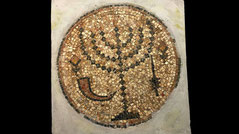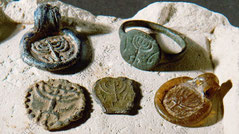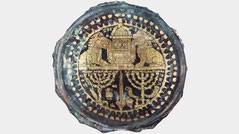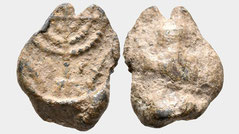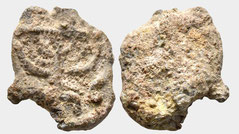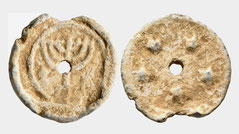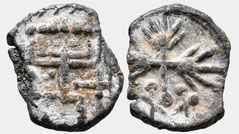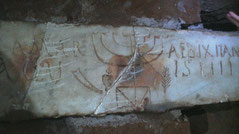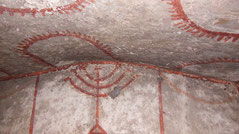Ancient Menorahs - 2nd Century AD / CE
This website shows ancient Menorahs from the second century. Menorah illustrations from other centuries: Ancient Menorahs until the 1st century, 3rd century, 4th century, 5th century, 6th-10th century, 11th-13th century, 14th century, 15th century, 16th century, 17th century, 18th century, 19th century, 20th century, 21st century, Coins and Medals, Ancient Oil Lamps

100-300. Ancient Roman gold & glass Menorah pendant. Aubergine and milky white glass color pendant, engraved with a Menorah, set in high karat gold. Length: 2.8 cm. including loop. Source: Link
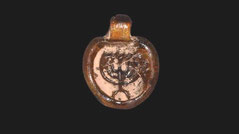
2nd-3rd century AD. An amber-colored glass pendant with integral loop, high-relief menorah symbol to one face. 3.27 grams, 27 mm (1"). Property of a London gentleman; acquired by his father in the 1970s; thence by descent. LiveAuctioneers 2019, Lot 1013. Source: Link

100-300 AD. Roman bronze ring. Diamond shaped ring with crescent designs, probably representing two Menorahs opposite each other. Size: 8 (American size) Diameter: about 2 cm. Source: Link

100 AD. Ancient Bronze Menorah ring from the Second Temple Period. Torah-Museum. Source: Link

100 AD. Rare ancient Roman stone seal with menorah. Heigh 1 1/4". LiveAuctioneers, Lot 0278. Source: Link
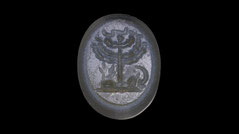
2nd-3rd century AD. An early Jewish nicolo ring stone. The flat oval stone engraved with a menorah, a lamp resting on each arm, with two lulavim (palm branches) in a vessel on one side, an etrog (citron) and shofar (ram's horn) on the other, on a groundline. Size: ½ in. (1.2 cm.) long. Christie's, Sale 1914, Lot 343. Source: Link
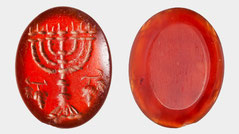
2nd-3rd century. The carnelian stone seal gem, which was once mounted in a ring as a personal seal, is engraved with a menorah flanked by bunches of grapes. The style of engraving and the shape of the gem are very similar to contemporary pagan examples. Dimensions: 15 x 12,5 x 45 mm. Donated by P. Romanoff in 1944 originally from the Azeez Khayat Collection in 1922. The American Society, New York (0000.999.36807); from the collection of E.T.Newell. Source: Link1, Link2, Link3
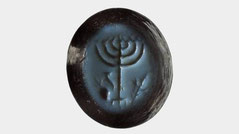
2nd-3rd century. In the Roman City of Ammaia (Portugal) we have a ring stone with a menorah. The Roman town of Ammaia was founded in the 1st century, likely under the reign of Claudius. The Roman ruins of Ammaia are located within the Nature Park of the Serra de São Mamede, a mountainous expanse of forest in the civil parish of São Salvador da Aramenha, municipality of Marvão, along the border with Spain. Source: Link1, Link2
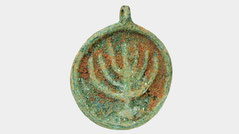
100 AD. Bronze pendant with the seven-branched Menorah, the symbol for Light, Justice, Peace, Truth, Benevolence, Brotherly Love and Harmony. Loop at the top for wear ability. Rich green patina with some encrustation. Source: Link
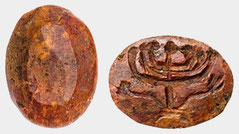
2nd-3rd century. Intaglio. Red Jasper. Menorah. Roman Provincial, 15.7 x 11mm. Seven-armed menorah, branch emerging from either side of base. Auction 342, Lot 45. Source: Link

2nd–3rd century AD (Henig - MacGregor). Seven-branched candlestick (menorah), with the three inner branches formed as standards with crosses on medallions. The branches are topped with oil lamps. Collection: GB_Oxford, Ashmolean Museum. Source: Link

2nd-4th century. An ancient Jewish glass fragment. Pale yellow-green in color, preserving part of one side of a four-sided vessel, mold-blown with a medallion at the center in raised relief depicting a seven-branched menorah flanked by a shofar and lulav, encircled by a wreath knotted at the bottom end, the ties extending to either side. Size: 5¼ in. (13.3 cm) long. Christies, Sale 1244, Lot 161, Source: Link
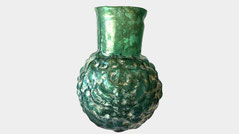
100-300 AD. Ancient Roman glass jar, decorated with a menorah for the Jewish symbol, lovely green color glass, intact. Size : 8 cm x 6 cm. LiveAuctioneers 2015, Lot 0227. Source: Link
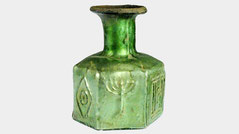
100 AD. Green mold-blown hexagonal shaped glass pilgrim jar with flattened shoulders, cylindrical neck, flaring mouth, rolled rim, decorative Menorahs, Lozenges and Temples, some iridescence and encrustations. Size: 3" x 2 ½". Sadigh Gallery. Source: Link

100-300 AD. Golden amber mold-blown hexagonal shaped glass pilgrim jar with flattened shoulders, cylindrical neck, flaring mouth, rolled rim, decorative Menorahs, Lozenges and Temples, some iridescence and encrustations. Size: 3 ¼" x 2 ½". Source: Link
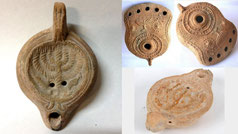
Various Oil lamps with a Menorah. See: Ancient Menorah Oil Lamps - 2nd Century

2nd-4th century. Lead seal depicting a menorah. Roman, possibly Egyptian. Face depicts a seven-branched menorah flanked by shofar, lulav (18x11mm, 2.55g). Although Alexandria is known as the academic capital of the Hellenistic and Roman world, the city was also remarkably cosmopolitan. The Jewish population there represented one of the largest ethnic groups and inhabited as many as two of the five boroughs of the city. Although a notoriously insular society, the Jews began to open up to Greek culture. Link1, Link2
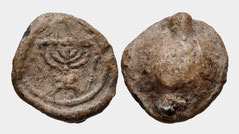
2nd-4th century. Ancient Jewish lead seal. Conical Seal (13mm, 2.92 g). Perhaps Alexandrian. Menorah of seven branches, flanked by a shofar and lulav. CNGCOINS, 245, Lot: 530. Source: Link
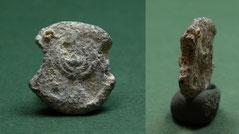
100-300 AD. Ancient Jewish menorah lead Bulla. Probably with an image of the Jewish menorah in relief. Size: 1.7 X 1.4 cm. Source: Link

100 AD (probably). Ancient Roman Bronze Menorah. Dimensions: Width: 2.5in, Height: 1.9in. Ander's Auction. Source: Link

2nd-3rd century. The Athena relief of Sömek is a Greco-Roman rock relief, located some two kilometres north of the village of Sömekin Silifke district of Mersin province in Turkey ("Rugged Cilicia"). Athena is the daughter of Zeus. Depiction of a menorah (?) (a 5-branched variant type) next to a relief depicting Athena. However, this is not the biblical menorah). Serra Durugönül dating the relief to the 2nd century, on the basis of comparison with other rock reliefs of Asia Minor. Source: Link1, Link2

2nd-4th century. Many inscriptions in Greek were excavated by the Princeton University Archaeological Expedition to Antioch on the Orontes, Syria, ancient Greek city, today Turkey. Fragment of pink-veined marble gravestone with a Greek inscription below the design of a menorah (seven-branched candlestick). The fragment measures 14.7 by 10.7 cm and a thickness of 2.4 cm. Source: Link

100-400 AD. Roman Period Basalt Fragment from a Synagogue Column Depicting a Menorah. Origin: Syria, Gallery Location: USA. Dimensions: 17.5″ (44.5cm) high. Carved in relief on a rectangular block of volcanic rock is the symbol of Jewish religion, the Menorah. The curve of the upper part of the block matches the curve of the Menorah's top bar. Three semi-circular branches join this bar and the central shaft, which is attached to a base in the form of a square. Source: Link1, Link2

2nd century. Marble Plaque for Donation to a Temple, made by a temple official and his family. 2nd century version of, 'Mazel tov, Ethan, from the Bernsteins'. Inscribed in Greek: "Through the providence of God, I, E...s; Elder and Trustee, together with my wife and my children, have renovated the forecourt of the sanctuary using the gifts of God". In Hebrew: "...established the house of prayer. Peace". Source: Link
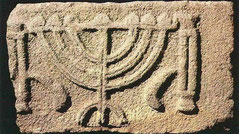
100-300 AD. Roman Period Lintel from a Synagogue Depicting a Menorah. The carved stone once stood over the doorway of an ancient synagogue. Its images depict Jewish ritual objects, with a menorah as its central focus. An ancient symbol of a faith much older still, this lintel serves as a reminder of what has endured across the ages. Origin: Israel. Medium: Basalt. Style: Roman Period. Source: Link1, Link2, Link3
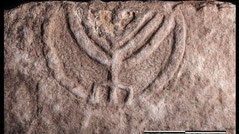
2nd-4th century. Ancient tomb door with stunning menorah carving revealed in Israel. The door was discovered in Tiberias in Israel’s Galilee region in 2010 by archaeologists from the University. The tomb door is ornamented with a depiction of the seven-branched menorah. Photo by Tal Rogovsky. Source: Link

100-300 AD. Ancient Roman Holy Land Stone Menorah. height: 13in, width: 15in, weight: 63lbs. Liveauctioneers; Lot 0346. Source: Link

2nd-3rd century. Basalt relief with Menorah. Culture: Roman, Syrian. Dimensions: H. 29.9 cm (11 3/4 in.); W. 47 cm (18 1/2 in.). Copyright © The Yale University Art Gallery. Source: Link

100-300 AD. Ancient Holy Land. Carved gray basalt panel with a menorah from a temple. Dimensions: 18" x 12" x 3 ¾". Source: Link

100-300 AD. Roman period basalt lintel from a synagogue depicting a menorah, shovel and a shofar. Size: 66 in. (167.6 cm). Origin: Houran (Syria), found among the remains of an ancient Beit Knesset in the Golan. This basalt lintel reveals that Judaism continued to thrive in Ancient Israel despite the brutal repression of the Roman Occupation. A testament to an ancient faith, this rare lintel once guarded the entrance to a synagogue. Source: Link1, Link2, Link3, Link4

100-300 AD. Carved limestone wall fragment depicting a kneeling priest and a seven-branched Menorah. Earthen patina. Dimensions: 5 ½" x 5" x 2". Source: Link

132–135 AD. As they huddled in the cistern of their Nahal Mikhmas cave, in a last-ditch effort to hide from Roman soldiers, Jewish refugees from the Bar-Kokhba Revolt drew messages in charcoal on the plastered walls, including this menorah. Source: Link

132-135 AD. An Aramaic/Hebrew inscription above a Byzantine-era cross and Second Temple-era menorah drawn in a cistern in the al-Aliliyat cliffs near modern Kfar Mukhmas. (Foto: Boaz Langford). First uncovered 40 years ago during archaeological surveys at Michmas (today the Arab village Kfar Mukhmas), a Hasmonean stronghold during the Maccabean Revolt, the drawing was never published by scholars and its documentation was left to gather dust on archive shelves. Source: Link

2nd century. Engravings of a seven-armed menorah (left) and a cross were carved thousands of years ago in a cave in southern Israel. Archaeologists with the IAA dated the menorah carving to the 2nd century AD and the cross to the 4th century. © Sa'ar Ganor, Israel Antiquities Authority. Source: Link1, Link2

2nd century. Ostia Synagogue. Lulav, Etrog, Shofar and Menorah. The Ostia Synagogue is an ancient synagogue located in ancient Ostia Antica, the seaport of Imperial Rome. It is one of the oldest synagogues in the world, the oldest synagogue in Europe and the oldest outside Israel. Source: Link1, Link2
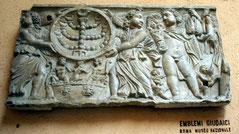
2nd-3rd century. Rome, Catacomb Vigna Randanini. Cast of a Jewish relief (showing putti bearing a menorah). On this fragment of a marble sarcophagus, the menorah is enclosed in a roundel, which is supported by two winged Victories. This was adopted from a Roman design in which the medallion usually contained portraits of the deceased. Kircher Museum. The original stands in the Museo Nazionale Romano. Source: Link1, Link2, Link3, Link4

2nd-4th century. Beit She'arim National Park (Beth Shearim; Beyt ha Shaarim). The bas-reliefs and drawings are representative of Roman-period Jewish folk art. The artwork in all the caves contains Jewish elements, such as the seven-branched candelabrum, the Holy Ark, a ram's horn (shofar), and a palm branch and citron (lulav and etrog). Secular themes, including boats, animals, human figures, and geometrical designs, also appear. Source: Link1, Link2

2nd-4th century. Rock-cut tombs in Beth Shearim National Park, located 20 km east of Haifa. An example of the intricate carvings in the catacombs, this menorah stands on top of the head of a man in a Roman military tunic. Jewish symbols such as the menorah appear side by side with pagan motifs of lions, eagles, bulls’ heads and garlands. A carved shell, another common ornament, decorates the burial niche on the right. UNESCO World Heritage Site since 2015. Link1, Link2, Link3, Link4

2nd-4th century. A menorah in a Beit She'arim burial cave. Same picture as above but from another perspective. Beit She'arim was a prosperous settlement during the period of the Mishnah's redaction (1st to 3rd centuries ACE) and the site includes 30 burial caves where rich people and scholars of the period were buried. Beit She'arim is the ninth site in Israel to be recognized by UNESCO as a World Heritage Site. Photo: Israel Nature and Parks Authority. Source: Link
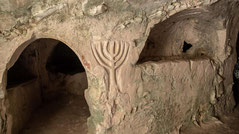
2nd-4th century. Beth She'arim Catacomb 4, Hall A. 7-branched menorah with a Greek inscription above it is placed on the wall to the left of arcosolium. The stem and branches of the menorah are depicted as simple stripes. The branches broaden at the top. The stem stands on a base with rounded top corners. The inscription is placed at the upper left side of the menorah. It consists of three lines and reads as follows: "We (are the sons) of Leontios from Palmyra, the banker." Source: Link, Link2

2nd-4th century. Beth She'arim Catacomb. 4, A seven-branched menorah flanked on both sides by a rosette is placed on the arched passageway leading from room VI to room VII. The menorah has the form of a stylized plant: the 7 branches issue from a short, tree-like stem. To the right of the menorah is a rosette consisting of six petals within a circle. To the left is a bigger, incomplete whirling rosette within a circle, above is carved a geometric object resembling a square. Source: Link1, Link2, Link3

2nd-4th century. Ancient graffiti in Israel. A carved decorative scene depicts an architectural structure that includes an arch over a menorah at the center and four columns. Two leaping lions once flanked the top of the central arch, but the left lion has since been destroyed. Jews were exiled from Jerusalem after a revolt in A.D. 132. Beit She'arim, established by a fabled Jewish rabbinical prince, Judah, became a refuge for him and his followers. Photo by W. O'Leary. Source: Link

2nd-4th century. Beit She'arim National Park. The residents of Beit Shearim dug an ornate necropolis deep into the ground. Courtyards, corridors, and staircases lead to the catacombs with their burial chambers and stone sarcophagi. The chambers and sarcophagi are decorated with bas-reliefs, epitaphs, and frescoes. The mouths of some of the caves were closed with hewn stone doors, shaped to resemble wooden doors. Source: Link1, Link2, Link3, Link4 More photos from the 3rd century.
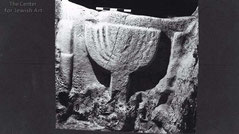
2nd-4th century. Wall carving (Decoration). Origin: Syria-Palaestina, Beth She'arim, Catacomb 1, Hall O, Room III. A nine-branch menorah flanked by two columns is placed on the outer wall of the arcosolium. The menorah has the form of a semi-circle resting on a short stem that seems to issue from the rough rock near the floor of the room. Object Copyright National Parks Authority. Photograph Copyright: Center for Jewish Art. Source: Link

2nd-4th century? The mortuary context of this menorah (cut onto a doorjamb of Catacomb 12 in Beit Shearim) suggests that graffiti were meant to somehow assist the deceased or sanctify the space. This and similar graffiti also show that - despite rabbinic disapproval of spending excessive time in impure places - some Jews spent protracted periods of time in cemeteries and burial caves. Book of Karen B. Stern: "Writing on the Wall: Graffiti..." Photo: Ezra Gabbay. Source: Link1, Link2, Link3

2nd-4th century. Wall carving of a Menorah from Beth Shearim. The seven-branched menorah is placed on the left wall of the corridor above the entrance to the hall. The six lateral branches of the menorah issue from the short stem. They are represented by simple stripes. The central branch is replaced by a smaller seven-branched menorah. Location: Israel: Beth She'arim: Catacomb 1, Corridor. Photograph Copyright: Center for Jewish Art. Photo Number: 4957. Source: Link

2nd-4th century. Menorah carvings on the wall of the burial chambers at the Beit Shearim caves in the Yizreel Valley. Source: Link

2nd-4th century. Wall carving from Beth Shearim. A seven-branched menorah flanked on either side by a column is carved on the left wall of the passageway. The columns support an architrave. The menorah occupies the entire area between the columns, from the floor to the architrave. Its branches issue from a central stem which widens towards the bottom and ends in a broad ring. The ring is set inside a round depression at the top of the base. Source: Link

From the 2nd to the 5th century the catacombs were built in Rome. Antonio Bosio (†6. September 1629) has investigated the Jewish catacombs on the via Portuense and has published the paintings in his books of 1632-1634. Jessica Dello Russo: "The Monteverde Jewish Catacombs on the via Portuense". Source: Link1, Link2, Link3

2nd-5th century. Illustration of two candlesticks from the book of Antonio Bosio (1576-1629) on the catacombs of Rome. Original title: "Roma sotterranea, opera postuma di Antonio Bosio Romano... Composita, disposta et accresciuta dal M. R. P. Giovanni Severani di San Severino". Year printed: 1632. Language: Italian. Publisher: Severano, Giovanni (1562-1640). Faksimile of the book: University of Freiburg and University Köln, Germany. Source: Link1, Link2, Link3

2nd-3rd century. Slab from Jewish Catacomb: “Here lies Faustina. In Peace.” It is highly probable that the first Roman Catacombs were excavated by the Jews because they were opposed to the Roman practice of burning the dead. This curious epitaph, written in Hebrew, Greek, and Latin, probably belonged to a Christian Jewess. The figure to the left may be a horn, the letters at the right are probably intended for the Hebrew word Shalom. Source: Link1, Link2, Link3
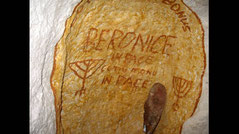
2nd century. Venosa, Jewish catacomb, Basilicata. The Jewish Catacombs of Venosa are a set of catacombs located near the Italian city of Venosa, Province of Potenza. The exact date of construction for the catacombs is unknown, but it seems likely that they were built and used between the 4th and 6th centuries C.E., and their existence has been known since the 19th century. Jewish Virtual Library. Source: Link1, Link2

2nd century. A menorah was carved into the steps by some unknown Jewish resident of Ephesus (Turkey) sometime after the building of the library. Why is this carving so important? Because it is the only archaeological evidence we have for the existence of a Jewish community in Ephesus. Source: Link1, Link2
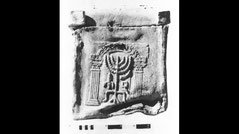
2nd-3rd century. The Menorah coffin from Beth She'arim. Sarcophagus. Center for Jewish Art. Source: Link

2nd-4th century. The bas-relief of the Jewish sarcophagus. Catacombs of Torlonia, Rome. Only the menorah, lulav and etrog are represented. Nothing superfluous, no mythological characters and pagan symbols. Department of Antiquities of Rome, National Museum, Rome, Italy. Source: Link

2nd-4th century. Jewish Catacombs in Rome, Vigna Randanini. Catacombsociety. Source: Link
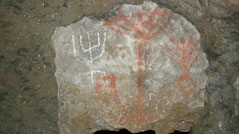
2nd-4th century. Jewish Catacomb of the Vigna Randanini. Detail of partially-sealed kokh tomb in D4, decorated with images of menorah, shofar and etrog. Source: Link

2nd-4th century. Detail of menorah painted in the plaster beside doorway into cubiculum in Vigna Randanini Catacomb in Rome. Picture from the PDF "ICS On-Site in the Vigna Randanini Catacomb. Fall 2001, Jessica Dello Russo." Source: Link
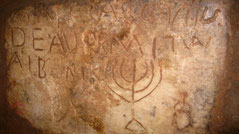
2nd-4th century. The Vigna Randanini catacombs in Rome are unique for the extent of the decoration. About 25-30% of the inscriptions are in Latin or Aramaic. The rest are in Greek, suggesting that language was the language of most use to a large part of the immigrant population. The Vigna Randanini are Jewish Catacombs between the second and third miles of the Appian Way (Via Appia) close to the Christian catacombs of Saint Sebastian, with which they were originally confused. Source: Link
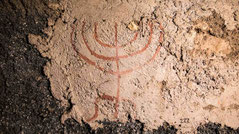
2nd-5th century. As in most of these underground cemeteries, the dead of Villa Torlonia were buried in loculi - rows of niches carved into the soft tufa stone and then sealed with plaster. The cover would often be inscribed with the name of the deceased. Those who could afford it were buried in larger chapels with arched niches, whose walls and ceilings were elegantly decorated with Jewish motifs: menorahs, Ark of the Covenant, or symbolic fruits: pomegranate and the etrog. Source: Link
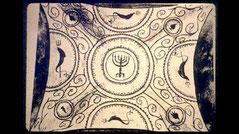
2nd-4th century. Owners of burials in the catacombs of Torlonia preferred to place in the center of the "heavenly vault" a seven-branched menorah. The central circle is surrounded from 4 sides by semicircles with inscribed dolphins carrying tridents. The grapevines, dolphins, and tridents were derived by both Jew and Christians from Graeco-Roman iconography. Drawn from J. B. Frey C. S. Sp., Corpus Inscriptionum Iudaicarum (Città del Vaticano, 1936. Reprint, New York, 1975), p. CXXVII. Source: Link1, Link2

2nd-3rd century. Iron Age Danubian Votive Plaque with Goddess. A round lead plaque with the figure of a goddess in the centre with horsemen to either side of her with cockerel and attendant figure; the sun, moon, candelabrum (menorah?) and fish in the upper register, lower register with various animals. The Danubian Riders were associated with a mystery religion of the Getae and the Dacians (Romania). The cult began to spread among Roman soldiers soon after 106 CE. Source: Link
Menorah Pictures from other Centuries:
Until the 1st, 3rd, 4th, 5th, 6th-10th, 11th-13th, 14th, 15th, 16th, 17th, 18th, 19th, 20th, 21st Century
Note: It's nice to see the menorah pictures. However, according to the Bible Jesus (Hebrew Yeshua) is the true spiritual meaning behind
the physical Menorah. He is the true and eternal spiritual light: "I am the light of the world. Whoever follows me will never walk in darkness, but will have the light of
life" (John 8:12). The menorah also symbolizes the Tree of Life, because Jesus is the way to life: "I am the way, and the truth, and the life. No one comes to the Father except through
me" (John 14:6). Jesus' Word and the Bible are the light in this world. "Your word is a lamp to my feet and a light to my path" (Ps 119:105 and John 1:1-17).
Copyright info and disclaimer: All content and all photos from ancient and new menorahs provided on this website is for informational purposes only. It is not allowed to publish photos from this website on other websites or printed literature. Please always use only the original sources of the photos. We make no representations as to the accuracy or completeness of any information on this website or found by following any link on this website. We will not be liable for any errors or omissions in this information. We will not be liable for any losses, injuries, or damages from the display or use of this information. We can not guarantee the validity and accuracy of the information, please always check the original source. The opinions expressed from other website owners and those providing comments are theirs alone, and do not reflect the opinions of us.
